Display
The 5" AMOLED display is very colorful and sharp looking, though it's HD 1280 x 720 rather than full HD 1920 x 1080. Honestly, with a quality panel at 4.7", that's plenty enough resolution and pixel density (312 PPI) for very sharp text and crisp images. At normal viewing distances, the human eye can't see the difference once a display reaches or surpasses 300 PPI. Colors aren't terribly exaggerated and there's no noticeable color bias so whites look white. This is an RGB stripe display rather than Pentile Matrix, which helps apparent sharpness. For those who like a bit of added vibrancy, but don't want exaggerated, cartoony colors, the AMOLED display on Motorola's recent smartphones are a solid pick. The display is decently bright, though AMOLED displays aren't the best for combating bright sunlight (the HTC One wins that contest) and auto-brightness is ever so slightly dim, though not so much as the Samsung Galaxy S4.
Performance and Horsepower
Motorola and Google are ignoring the specs war that seemingly obsoletes solid high end smartphones months after they've come out. I say seemingly because these phones are still very fast and have sharp displays with high pixel density, but in a paper specs war, they look weak. We don't need supercomputers in our pocket and Android phone manufacturers are using specs rather than solid features and designs to evolve their products. Now, this isn't true of every Android phone on the market; clearly HTC went with a classy and bold new design with the One and Samsung's interested in throwing a bucket of software features at us to see what sticks. But still, these flagships must feature faster CPUs with more cores, and pixel density well beyond what the human eye can appreciate to keep up with the smartphone Joneses.
Instead, Motorola went with two additional custom cores that handle always-on voice and motion input rather than bogging down the dual core main CPU. They call it the Moto X8 computing system, and you'll also find it in the fall 2013 Motorola Droid lineup on Verizon. Like the Droid Ultra, the phone can listen for your commands even when sleeping and it can handle any command that Google Now supports (finding Chinese food, getting directions, launching an app and much more). It handles natural language queries like Apple's assistant, though its responses to oddball questions aren't humorous like Siri's.
The Moto X runs on a custom 1.7GHz dual core Snapdragon S4 Pro (which usually has 4 cores). These are two Krait 300 cores with Adreno 320 graphics, so performance and benchmarks are actually very good even if they don't beat the two top speed demons, the Samsung Galaxy S4 and HTC One. Actually, graphics benchmarks match those two top Android smartphones since they all use the Adreno 320 GPU. In use, you won't feel the difference between those two phones and the Moto X plays 3D games such as Real Racing 3 and N.O.V.A. 3 like a champ. There's no lag and no heavy UI overlay to slow things down. In fact, it's more responsive than the Samsung Galaxy S4 that's often bogged down by Samsung's TouchWiz UI overlay and myriad software features.
Benchmarks
Quadrant: 8357
AnTuTu: 21,377
Sunspider: 1097
3DMark, Ice Storm test (standard): 11,376. Demo: 64.9 fps
3DMark, Ice Storm test (extreme): 6,800. Demo: 28.5 fps
| |
Quadrant |
GLBenchmark 2.7, 2.5 Egypt Offscreen |
AnTuTu |
Sunspider JavaScript Test |
| Moto X |
8357 |
43 fps |
21,377 |
1097 |
| Moto G |
8485 |
16 fps |
17,396 |
1311 |
| Motorola Droid Ultra |
8581 |
43 fps |
18,965 |
1191 |
| LG G2 |
19,762 |
57 fps (GLBench 2.7 used, so results are lower) |
32,990 |
823 |
| Samsung Galaxy S4 |
12,276 |
41 fps |
24,776 |
826 |
| HTC One |
12,252 |
37 fps |
24,589 |
1155 |
| Sony Xperia Z |
7916 |
32 fps |
20,403 |
1306 |
| LG Optimus G Pro |
11,994 |
28 fps |
18,561 |
867 |
| Motorola Droid RAZR HD |
5055 |
51 fps (v.2.1 used so score is higher) |
6760 |
1862 |
| Samsung Galaxy Note II |
6001 |
66 pfs (v.2.5 used) |
14,056 |
1052 |
| LG Optimus G |
7235 |
59 pfs (v.2.5 used) |
11,087 |
1289 |
| Samsung Galaxy S III |
5102 |
51 fps (v.2.5 used) |
7011 |
1825 |
Calling and Data
As we've come to expect from a Motorola handset, reception is good and call quality is excellent. Incoming and outgoing voice were loud and clear with a fullness that equals the excellent Samsung Galaxy S4 and HTC One. The Moto X worked well with our car's built-in Bluetooth, several current Motorola Bluetooth headsets and the Jawbone 2.
Data speeds on AT&T's 4G LTE network were par for the course in the Dallas area, which is to say excellent. We averaged 20mbps down and 15 mbps up according to the Speedtest.net app. Web pages load quickly, apps from Google Play load as fast as on a good WiFi connection and email attachments download in a flash.
Moto Software
- Active Notifications show the time and notifications such as new emails, text messages and more on the sleep screen. The notification screen appears when a new item arrives, and it shows when you move the phone. For example, if you take it out of your pocket or pick it up from the desk, you'll see the time and notifications so you needn't press the power button or unlock the phone. You can control what appears on the screen (in the interest of privacy) and you needn't wake the phone to see more info. If there's a new email, drag the email notification up and it will show you a preview of the new message. Motorola says this saves power since most users turn on the screen many times per day simply to check notifications and the time. The Active Notifications screen uses less power and keeps you informed. Once you get used to this feature, it's hard to go back.
- Touchless Control is Moto's name for voice command that's always listening, even if the phone is sleeping with the display turned off. Thanks to Moto's custom CPU for voice processing, it doesn't drain power madly as does Samsung S Voice with the always-listening function turned on. You'll have to preface your command with the phrase "OK Google Now" so the phone doesn't randomly respond to everything it hears. You'll train it to recognize your voice, and you must use the phrase "OK Google Now". I admit I feel a little silly saying that phrase, but I quickly got over it when I enjoyed asking the phone what time it was when the phone was in my pocket and my hands and eyes were busy playing Borderlands 2 on my PC. Then I set an alarm for 30 minutes... because you know how one loses track of time when playing a fun game. Yes, there are more serious uses like calling someone or composing a text message, and the phone handles those well too.
- Motorola Assist is the evolution of the work Motorola has done to automate tasks based on location and activity. The night mode can silence the phone for the hours you specify. It can automatically silence the phone during scheduled meetings. It uses the GPS and motion sensors to determine when you're driving and it enters car mode where it can announce caller's names and read text messages to you.
Camera
The Moto X has a 10MP rear camera that can shoot 1080p video and 60 FPS slow motion video too. The camera uses an RGBC sensor that should improve low light photos and video. In practice, it does handle low light well, and it maintains detail with decently controlled noise. Colors in general don't pop, but I wouldn't call them lifeless. While many camera manufacturers opt for increased saturation via camera firmware or post-processing in the camera app, Motorola leaves it to you to increase colors via the built-in editor or on the desktop with Photoshop. Honestly, we'd like to see them increase saturation via an update. On a positive note, images are sharp (but not oversharpened) with good detail, and tap to focus/shoot is very quick and burst mode works well. If you're coming from an older smartphone, the Moto X's camera will likely seem like a big improvement, even if it doesn't quite match the Samsung Galaxy S4, iPhone 5 and Nokia Lumia 925's best in class shots and video.
Do make sure to clean the lens since a smudged lens results in washed-out looking photos and video.
The phone has Moto's shake to shoot feature where you snap your wrist twice to wake up the phone and launch the camera app. Once you get a hang of the motion, it's a time saver. The camera uses an improved version of the vanilla Google camera application with a large arc housing settings. You swipe in from the left to bring up settings and swiping from the right takes you to Gallery. Settings are fairly basic with HDR (on/off/auto), LED flash control, touch focus on/off, slow motion video on/off, panorama on/off, shutter sound on/off and Quick Capture (shake to launch the camera app) on/off. You can play with color effects and filters after shooting a photo using the editor, rather than in the camera app before shooting.
Battery Life
All the work that Motorola did to improve battery life by incorporating low power cores to handle speech and motion while halving the central processing cores has paid off. Likewise, the fairly clean Android build that eschews UI ornamentation and a feature parade contribute to good battery life. The Moto X's 2200 mAh Lithium Ion battery is sealed inside and I've had no trouble making it from 7am to 11pm on a charge with moderate use on AT&T's LTE 4G network. I've streamed HD video for 45 minutes, used push email, surfed the web for an hour on Chrome, played an hour of music with the screen off, made 30 minutes worth of calls and played 30 minutes of Real Racing 3 and Riptide GP 2 and had 20% charge left at bedtime.
Conclusion
I think you get the idea: I really like the Moto X. I own a Samsung Galaxy S4 and an HTC One, but over the past 3 weeks I've found myself choosing the X. Why? It's a tad smaller, just small enough to fit in my pocket and stay there. It feels great in the hand, so good that I find myself holding onto it even when I don't really need to. I love simply picking up the phone to see notifications without having to wake it up and swipe across the screen. I frequently use the voice command feature, even when it's in a bag or my pocket. It's a phone that's meant to be used rather than a pocket rocket that computes pi faster than its competitor. It feels human and useful, something I didn't particularly expect from a company owned by Google, the king of machines. It takes pretty good photos and videos that will be plenty good enough for most folks even if it doesn't beat the top camera phones. It's fast and has good battery life. The screen is pretty with bright colors and deep blacks. Lastly, depending on your carrier, you can order it with your choice of colors, though I find the stock woven Kevlar black to be attractive and timeless. I'm glad that Motorola rethought what it means to be a flagship phone; Apple needs a rival that thinks about usability and human interaction.
Price: $199 with contract, $579 without contract
Websites: www.motorola.com, wireless.att.com, www.verizonwireless.com
Related:
Moto X 2014 (2nd gen) Review
Moto G 2nd Gen (2014) Review
Moto G (first gen) Review
Sony Xperia Z3 Compact Review
Samsung Galaxy Alpha
Moto Droid Ultra Review
LG G2 Review
HTC One Review
Samsung Galaxy S4 Review
Sony Xperia Z Review
iPhone 5s Review
Nokia Lumia 1020 Review
iPhone 5 Review
Moto X vs. LG G2 Comparison |
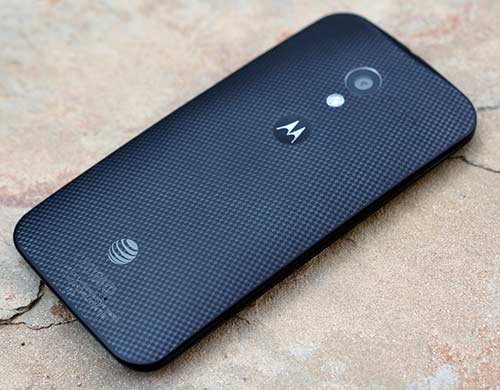
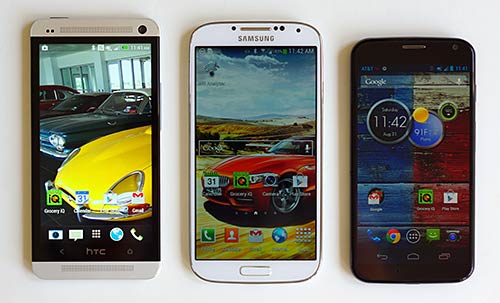
The HTC One, Samsung Galaxy S4 and Moto X.
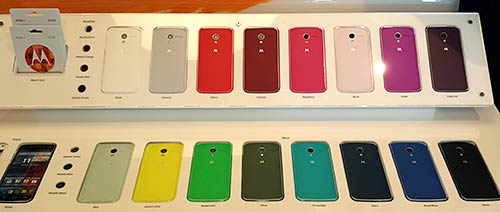
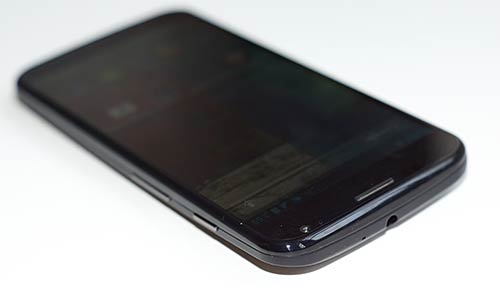
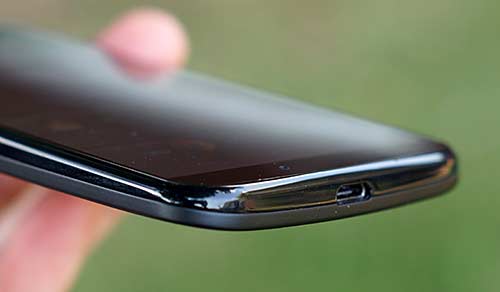
|

